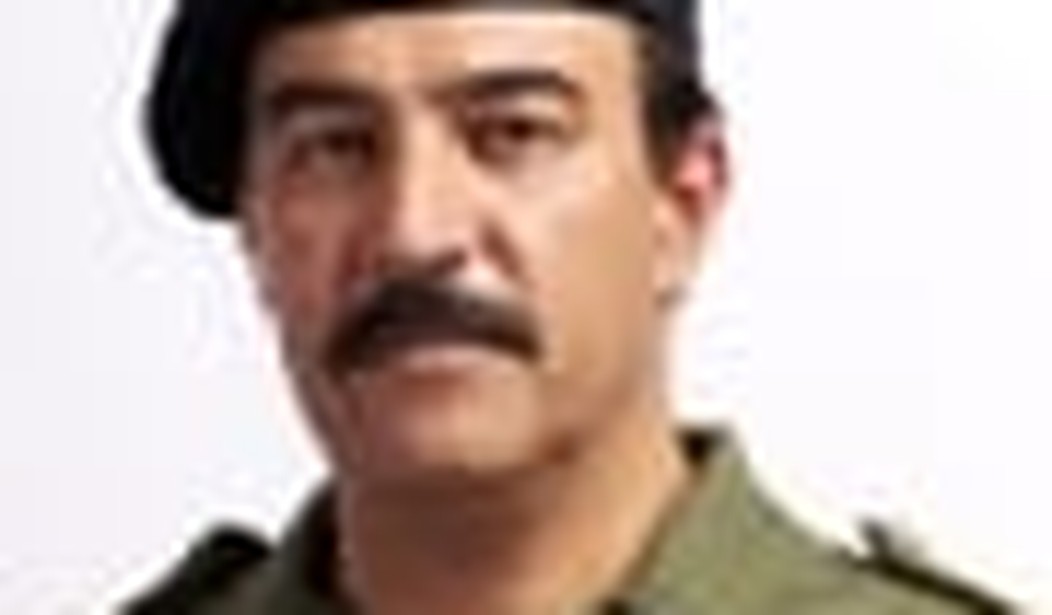Anyone hoping HBO’s new miniseries House of Saddam will make anti-warriors reconsider their stance on the Iraq invasion will be disappointed.
No Oil for Food scandal mentions. Little talk of mass graves or torture chambers beyond a casual reference or two during news reports spliced into the story.
Saddam, a joint venture between the pay cable giant and BBC Films, spends far more time dissecting the dynamics of the Hussein family than detailing his innumerous crimes against humanity.
That’s not unforgivable for an entertainment channel project, especially since the miniseries includes a number of gripping sequences that bring the late leader to inglorious life.
The four-part miniseries airs its first two installments tonight at 9 p.m. EST on HBO (Dec. 7). The final two chapters air the same time next Sunday (Dec. 14).
Comparisons to HBO’s The Sopranos are inevitable, even if Tony’s New Jersey haunts look nothing like the sand-blown stretches of Tikrit. Saddam took heat from his outspoken mother, dealt with a seriously disturbed, under-achieving son, and considered loyalty the highest of all attributes.
He also considered marital fidelity an optional part of the wedding vows and could have shed a few pounds.
But the stakes are so much bigger than what Tony and co. dealt with on that HBO series.
The story opens during the summer of 1979, as Saddam forces Iraq’s president out of office and takes the position for himself. Those officials who disagree with his muscular coup are assassinated in a quick but brutal sequence. Clearly, dissension demands the death penalty, a theme which will haunt Saddam’s political legacy.
His cult of personality began early, with school children instructed to sing his praises and media outlets feeling a collective thrill up their legs via their adoring coverage.
The miniseries tackles Saddam’s life from here in stages. The first hour focuses on his early days in office — and how he feared traitors at every turn. Even those closest, and most loyal, to Hussein eventually were killed in his obsession for total control.
The second recalls his disastrous decision to wage war with neighboring Iran, and the manufactured reasons for Iraq’s invasion of Kuwait.
Next week, the story turns to the mid 1990s, when economic sanctions left the Middle Eastern nation all but crippled. The series wraps with Saddam’s final days as a free man, as he scurries from one hiding spot to another as U.S. forces search for the deposed leader.
Four hours should be enough time to paint a sober portrait of most men, but House of Saddam sheds little new light on what made Saddam tick. One longs for some scenes of a young Saddam to see where his belief system sprang from.
And why does such a seemingly smart man make so many calamitous errors, both political and moral?
The project’s co-screenwiter, Alex Holmes, says he did all he could to patch together the true story of the regime, a chore made harder by the web of misinformation about the man and his impact. His film only scratches at Saddam’s imperial surface, but kudos for not wedging op-ed elements into the narrative. Viewers can moan about what House leaves out, but its overriding mission is to reveal a mob-like rule’s fall, not to directly speak of his own ideological bent.
Bones may be picked concerning the final hour, as we watch a bearded Saddam hiding out from coalition forces. The sequences are fascinating, no doubt. Here’s a man who once strode through his country’s most opulent palaces forced to scrounge for food and shelter, his once black hair now streaked with gray.
But it’s hard to believe Saddam was so avuncular during his flight. Here, he swaps cooking anecdotes with his dwindling band of bodyguards and bonds with a local boy at a quiet fishing pond.
Where is the madman, the fool who defied the world and soon learned he couldn’t get away with it any more? By this point in the miniseries, Saddam has become a sympathetic leader, a man gravely concerned for his family and willing to rally his citizens against the occupying force.
The film never addresses the missing, or nonexistent, weapons of mass destruction, although a scene set in the 1990s shows Iraqi workers hiding biological weapons from UN inspectors.
Israeli actor Igal Naor efficiently captures Saddam’s burly presence, his rumbling voice more than compensating for his limited screen presence. Other standouts include Philip Arditti as Uday Hussein, the crazier of Saddam’s two sons, and Amr Waked as a loyal Saddam soldier who can’t make peace with the politics of his leader’s inner circle.
House of Saddam uses Saddam’s reign as an excuse to tell an original gangster tale. It does so efficiently, and with occasional bravura moments, but those looking for the full account of Saddam’s cruelty should look elsewhere.









Join the conversation as a VIP Member